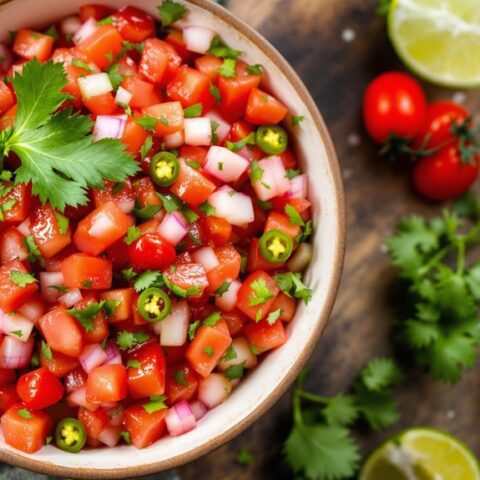
Orzo pasta is not a low-carb food, containing 44 grams of carbohydrates per 2-ounce serving, with approximately 39 grams of net carbs. While it offers 7 grams of protein and cooks faster than traditional pasta, its high carbohydrate content makes it challenging for low-carb diets. Smart alternatives include zucchini noodles (4g carbs), shirataki noodles (less than 1g net carbs), and cauliflower rice (5g carbs). Understanding orzo's nutritional profile helps create balanced, health-conscious meal plans.
Key Takeaways
- Orzo contains 44 grams of carbohydrates per 2-ounce serving, making it a high-carb pasta choice not suitable for low-carb diets.
- A single serving of orzo has 210 calories and 39 grams of net carbs, significantly higher than low-carb pasta alternatives.
- Whole-wheat orzo offers more fiber but maintains similar carbohydrate levels to regular orzo, comparable to brown rice.
- Despite having 7 grams of protein per serving, orzo's carbohydrates make up 21% of its total weight.
- Better low-carb alternatives include zucchini noodles (4g carbs/cup), shirataki noodles (<1g net carbs), and cauliflower rice (5g carbs/cup).
Understanding Orzo's Carbohydrate Content
When considering orzo pasta as a pasta option, understanding its carbohydrate content becomes essential for making informed dietary choices. A standard 2-ounce serving of orzo contains approximately 44 grams of carbohydrates, with net carbs reaching around 39 grams per serving. This positions orzo as a higher-carbohydrate choice compared to specialized low-carb pasta alternatives, such as Carbe Diem, which contains only 16 grams of net carbs. For those focused on healthy eating, it's worth noting that whole-wheat orzo offers improved nutritional benefits through increased fiber content, though its carbohydrate levels remain substantial. When compared to brown rice, orzo maintains similar carbohydrate levels but provides additional protein benefits. These nutritional characteristics make orzo best suited for moderate consumption, particularly for those monitoring their carbohydrate intake. Additionally, Shirataki Noodles offer a remarkably low-carb and low-calorie option with less than 1g carbs per serving, making them an excellent alternative for keto and low-carb diets.
Nutritional Profile at a Glance
A standard serving of orzo pasta contains 44 grams of total carbohydrates, representing its primary macronutrient component.
The pasta's protein content stands at 7 grams per serving, making it a moderate source of this essential nutrient.
When comparing the carbohydrate-to-protein ratio, orzo's composition shows it delivers considerably more energy from carbs than protein, with carbohydrates comprising approximately 21% of its total weight while protein accounts for just over 3%.
Carb Content Breakdown
The carbohydrate content in traditional orzo pasta presents significant considerations for those monitoring their daily macronutrients, with a single two-ounce serving containing 44 grams of total carbohydrates. This amount makes orzo a challenging choice for individuals following low-carb dietary protocols, especially when compared to alternatives like Carbe Diem Pasta, which contains only 16 grams of net carbs per serving.
While orzo does provide some nutritional benefits, including 7 grams of protein and 2 grams of fiber per serving, its overall carb content remains substantial at 210 calories per serving.
For those seeking to reduce their carbohydrate intake, the relatively high carb content of orzo may necessitate exploring alternative pasta options specifically designed for low-carb diets.
Protein Versus Carbs
Understanding orzo's nutritional composition reveals a distinctive balance between protein and carbohydrate content, with each two-ounce serving delivering 7 grams of protein alongside 44 grams of total carbohydrates.
This pasta variety offers a notable protein advantage over alternatives like brown rice, making it a considerable option for those monitoring their macronutrient intake.
Key points about orzo's protein-to-carb profile:
- Contains twice the protein content of brown rice per serving
- Provides moderate fiber content at 2 grams per serving
- Features higher net carbs compared to low-carb pasta alternatives
- Maintains a balanced macronutrient distribution suitable for general consumption
While orzo's carbohydrate content may not suit low-carb diets, its protein content makes it a viable option for those seeking to incorporate more protein into their balanced meal plans.
Comparing Orzo to Traditional Pasta
Orzo differs from traditional pasta types primarily in its carbohydrate composition, with higher carb content per serving compared to standard noodles like spaghetti or penne.
The rice-shaped pasta's unique texture creates a smoother, more grain-like mouthfeel than conventional pasta shapes, making it particularly suitable for soups and cold salads.
While most traditional pasta varieties require 8-12 minutes of cooking time, orzo typically reaches the desired al dente consistency in just 6-8 minutes, offering a quicker preparation option for time-conscious cooks.
Carb Content Side-by-Side
Comparing carbohydrate content between pasta varieties reveals considerable differences, with orzo containing 44 grams of carbohydrates per 2-ounce serving, slightly higher than traditional pasta's 39 grams.
This rice-shaped pasta, made from DURUM WHEAT, ranks higher in carbohydrates than many alternatives available to health-conscious consumers who still enjoy pasta and cook with it regularly.
- Traditional pasta contains 39g net carbs per serving
- Orzo contains 44g carbs per 2-ounce portion
- Low-carb alternatives like Carbe Diem contain only 16g net carbs
- Orzo provides 7g protein but falls short of low-carb options
For those monitoring their carbohydrate intake, specialized low-carb pasta alternatives offer notably reduced carb content while maintaining satisfying texture and taste profiles.
Texture and Mouthfeel Differences
When examining the textural characteristics between pasta varieties, the distinctive rice-shaped orzo offers a particularly different mouthfeel from traditional long-form pasta shapes.
Through specific cooking methods, orzo maintains a firm bite while developing a uniquely creamy consistency, especially in risotto-style preparations.
A detailed mouthfeel analysis reveals that orzo's compact size creates a distinct eating experience, with its ability to hold flavors from surrounding ingredients surpassing that of conventional pasta.
The orzo texture comparison highlights its superior capacity to absorb sauces and broths while retaining structural integrity.
Unlike larger pasta varieties, orzo's small shape allows it to achieve an ideal balance between tenderness and firmness when cooked properly, making it exceptionally versatile in both hot and cold applications.
Cooking Time Comparison
A notable time-saving advantage emerges in the comparison between orzo and traditional pasta varieties, with orzo requiring approximately 8-10 minutes to achieve ideal tenderness compared to the longer 10-12 minute cooking duration of standard pasta shapes.
The streamlined orzo cooking process maintains the same fundamental steps as traditional pasta while delivering quicker results, making it an excellent choice for efficient meal prep.
Key benefits of orzo's shorter cooking time:
- Faster weeknight dinner preparation
- Enhanced flavor absorption due to its small size
- Reduced energy consumption during cooking
- Greater versatility in quick-cooking dishes like soups
This time efficiency, combined with orzo's ability to rapidly absorb flavors, makes it particularly suitable for busy households seeking to optimize their cooking routine without sacrificing taste or quality.
Benefits and Drawbacks for Low-Carb Diets
Though orzo pasta presents challenges for individuals following low-carb diets due to its substantial carbohydrate content of 44 grams per 2-ounce serving, several factors make it worth considering as part of a balanced eating plan.
Low-carb orzo alternatives offer considerably reduced net carbs, containing only 5.5 grams per 100g when cooked, making carb moderation more achievable. The pasta's higher protein content of 7 grams per serving supports muscle maintenance, while meal balancing techniques, such as combining orzo with fiber-rich vegetables, can help manage its impact on blood sugar.
While traditional orzo contains less fiber than whole grain options, its versatility allows for strategic portion control and thoughtful meal planning, making it possible to incorporate this pasta variety into a carb-conscious diet when consumed mindfully. It is essential to be mindful of hidden added sugars in products accompanying orzo dishes, as they can disrupt ketosis and increase carb intake inadvertently.
Glycemic Impact and Blood Sugar Response
Understanding orzo's glycemic impact requires careful consideration of its substantial carbohydrate content and digestion patterns. Several glycemic response factors influence how orzo affects blood sugar management, including preparation methods and cooking time.
When consumed, orzo's 44g of carbohydrates per 2-ounce serving undergo relatively quick carbohydrate absorption, potentially causing notable blood sugar fluctuations.
Key factors affecting orzo's glycemic impact:
- Cooking duration – al dente preparation leads to slower digestion
- Whole wheat versus refined variants – higher fiber content reduces glycemic response
- Portion size and meal composition – pairing with fiber-rich foods moderates impact
- Individual metabolic differences – personal glucose tolerance affects response
For ideal blood sugar management, choosing whole wheat varieties and proper cooking techniques can help moderate orzo's glycemic effects while maintaining its place in a balanced diet.
Alternative Low-Carb Pasta Options
For those seeking alternatives to traditional orzo, several low-carb pasta substitutes offer nutritional advantages while maintaining the satisfying qualities of regular pasta. Vegetable-based options like zucchini noodles and hearts of palm pasta provide significant carbohydrate reductions, with some containing as little as 1-4g of net carbs per serving compared to conventional pasta's higher counts. Modern alternatives such as legume-based pastas and specially formulated low-carb products like Carbe Diem offer balanced solutions, delivering protein and fiber while keeping carbohydrate content manageable for health-conscious consumers. Incorporating non-starchy vegetables like spinach and kale into meals can further support low-carb goals while providing essential nutrients and fiber.
Popular Substitute Noodle Types
Looking to reduce carbohydrate intake while still enjoying pasta-like dishes? Several innovative alternatives offer considerably fewer carbohydrates than traditional pasta while maintaining satisfying textures and versatility in recipes.
- Zoodles (zucchini noodles) contain only 4 grams of carbs per cup, perfect for light zoodle recipes.
- Shirataki noodles boast less than 1 gram of net carbs, with remarkable shirataki benefits including zero calories.
- Spaghetti squash provides 7 grams of carbs per cup and naturally separates into pasta-like strands.
- Palmini pasta, made from hearts of palm, delivers just 4 grams of carbs per serving.
These alternatives not only reduce carbohydrate intake but also increase vegetable consumption, offering additional nutritional benefits.
Each option provides unique textures and flavors, making them suitable for various cooking applications and dietary preferences.
Making Smart Pasta Swaps
While traditional orzo remains a beloved pasta choice, modern alternatives provide compelling low-carbohydrate options without sacrificing the satisfying texture and versatility of conventional pasta. For those seeking healthy meal ideas, low-carb pasta alternatives offer significant benefits, including reduced calorie intake and increased fiber content.
| Feature | Traditional Orzo | Low-Carb Alternative |
|---|---|---|
| Carbs per serving | 44g | 16g |
| Fiber content | Lower | Up to 24g |
| Calorie reduction | Standard | 45% less |
| Pasta cooking techniques | Standard | Similar to traditional |
Understanding pasta cooking techniques remains essential when preparing these alternatives. The modified wheat starch and critical wheat gluten in low-carb options help maintain familiar textures while delivering substantial health benefits, making them excellent choices for those monitoring their carbohydrate intake.
Portion Control Strategies
Managing orzo portions effectively requires understanding both serving sizes and balancing strategies. A standard 2-ounce serving contains 44 grams of carbohydrates, making portion control essential for maintaining meal balance.
Portion control is key with orzo, as its carbohydrate-rich profile demands careful measurement to maintain nutritional balance in meals.
Success in managing orzo consumption relies on strategic fiber pairing and thoughtful meal composition.
- Measure a 2-ounce (56-gram) portion of orzo before cooking
- Fill half the plate with non-starchy vegetables for balanced nutrition
- Include protein sources like grilled chicken or tofu to enhance satiety
- Incorporate orzo into salads or soups for controlled portions
Best Cooking Methods for Orzo
Proper cooking techniques enhance orzo from a simple pasta to a versatile ingredient that complements any meal plan. The most effective method involves boiling the pasta in salted water for 8-10 minutes while stirring occasionally to prevent clumping. For flavor enhancements, consider using broth instead of water, particularly when preparing soups or stews.
| Method | Time | Best Used For |
|---|---|---|
| Boiling | 8-10 min | Basic preparation |
| Broth cooking | 8-10 min | Soups and stews |
| Cold rinse | 30 sec | Orzo salads |
When preparing orzo salads, quickly rinse the cooked pasta under cold water to halt the cooking process and maintain the ideal texture. For convenience, batch cooking and storing portions in the refrigerator or freezer allows for quick meal additions throughout the week.
Meal Planning With Orzo
Effective meal planning with orzo begins with portion control, measuring servings carefully to maintain balanced carbohydrate intake while incorporating this versatile pasta into weekly menus.
Strategic bulk preparation allows for convenient storage in refrigerated containers for up to five days, or freezer storage for up to three months, making orzo an excellent candidate for advance meal preparation.
Home cooks can create varied, nutritious combinations by pairing orzo with lean proteins, roasted vegetables, and fresh herbs, transforming basic ingredients into Mediterranean-inspired salads, hearty soups, or complete one-dish meals.
Portion Control Best Practices
While orzo's small, rice-like shape makes it a versatile pasta option, careful attention to portion sizes remains essential for maintaining balanced meals and achieving dietary goals.
Understanding serving suggestions and meal combinations helps create satisfying dishes while managing carbohydrate intake effectively.
- Measure a standard 2-ounce (56g) serving of dry orzo before cooking
- Allow for expansion to approximately 1 cup when cooked
- Combine with high-fiber vegetables to enhance satiety
- Pre-portion cooked orzo for consistent meal planning
For ideal portion control, incorporating orzo into soups and salads provides flexibility while maintaining dietary guidelines.
Measuring servings in advance and storing pre-portioned amounts supports successful meal planning, ensuring consistent portion sizes across various recipes and cooking methods.
Weekly Prep Storage Tips
Strategic meal planning with orzo benefits greatly from organized storage practices that maximize both convenience and freshness throughout the week. Implementing effective storage solutions can extend the pasta's shelf life while maintaining its quality. For ideal meal organization and prep efficiency, consider the following storage guidelines:
| Timeline | Storage Method | Tips |
|---|---|---|
| 3-5 Days | Refrigerator | Airtight container |
| 2-3 Months | Freezer | Spread on baking sheet first |
| Same Day | Room Temp | Cool completely before storing |
| Weekly Prep | Individual Portions | Add varied ingredients |
| Reheating | Any Method | Add liquid while warming |
When incorporating orzo into weekly meal prep, proper storage techniques guarantee the pasta remains fresh and ready for quick assembly. Pre-portioning cooked orzo with complementary ingredients creates convenient grab-and-go options while maintaining food safety standards.
Creative Recipe Combinations
Imaginative meal planning with orzo opens up countless possibilities for creating diverse and satisfying dishes throughout the week.
The pasta's adaptable nature makes it an excellent canvas for creative pairings and flavor infusions, allowing home cooks to experiment with various ingredients and cooking styles.
- Mediterranean-inspired orzo variations with olive oil, fresh herbs, and toasted nuts
- Asian-fusion combinations featuring sesame oil, edamame, and ginger
- Protein-packed orzo bowls with legumes, roasted vegetables, and zesty dressings
- Cold orzo salads with seasonal produce and light vinaigrettes
Health Considerations and Dietary Restrictions
Although orzo pasta is a versatile ingredient in many dishes, individuals with specific dietary needs should carefully consider its nutritional profile before consumption. Understanding dietary guidelines and health benefits is essential when evaluating ingredient alternatives for different nutritional requirements. For those managing type 2 diabetes, adherence to a ketogenic diet can significantly improve insulin sensitivity and reduce reliance on diabetes medications.
| Dietary Consideration | Orzo Suitability |
|---|---|
| Low-Carb Diet | Not Recommended |
| Gluten-Free Diet | Not Suitable |
| High-Fiber Needs | Limited Benefits |
| Weight Management | Moderate Portions |
With 44 grams of carbohydrates per 2-ounce serving, orzo may not align with low-carb dietary goals. While whole-wheat varieties offer improved nutritional value with higher fiber content, individuals with celiac disease or gluten sensitivity should avoid orzo altogether due to its wheat-based composition. Those seeking healthier alternatives might consider exploring gluten-free or low-carb pasta options that better suit their dietary needs.
Smart Substitutions for Lower Carb Counts
For individuals seeking to reduce their carbohydrate intake while maintaining the satisfying texture and versatility of orzo, several nutritious alternatives offer considerable carb reductions without sacrificing culinary appeal.
When exploring nutritional swaps, consider these low-carb alternatives:
- Cauliflower rice: Contains just 5g of carbs per cup, offering versatile flavor profiles and quick cooking techniques.
- Zucchini noodles: At 4g of carbs per cup, these provide a fresh, pasta-like texture.
- Konjac noodles: With less than 1g net carbs, these offer the closest pasta texture substitute.
- Lentils: While higher in carbs at 30g per cup, they provide additional fiber and protein benefits.
Additionally, using avocado oil can enhance the flavor and nutritional quality of these alternatives, ensuring dishes remain keto-friendly. These alternatives can be prepared using similar cooking techniques as orzo, making them practical substitutions in most recipes while considerably reducing overall carbohydrate content.
Recipe Modifications for Carb Control
When adapting traditional orzo recipes for lower carbohydrate consumption, strategic modifications can considerably reduce the overall carb count while preserving the dish's essential flavors and textures. Effective cooking techniques include reducing orzo portions while increasing non-starchy vegetables, which maintains dish volume while limiting carbohydrates. Additionally, incorporating high-fiber ingredients like legumes provides beneficial nutrients and helps regulate blood sugar levels. For enhanced taste without added carbs, flavor enhancements such as fresh herbs, spices, and healthy fats can complement orzo alternatives like cauliflower rice or zucchini noodles. When orzo is essential to a recipe, choosing whole-grain varieties and carefully measuring portions allows for better carbohydrate control while still delivering the desired pasta experience. These modifications guarantee satisfying meals that align with lower-carb dietary goals. Effective meal planning is crucial in ensuring that these modified recipes fit into a structured diet while minimizing food waste and maintaining nutrient balance.
Expert Tips for Incorporating Orzo
Successful incorporation of orzo into meals requires thoughtful preparation and strategic cooking approaches. Culinary experts recommend various orzo cooking techniques and orzo flavor pairings to maximize both nutrition and taste.
By implementing strategic orzo serving suggestions and combining this versatile pasta with fiber-rich ingredients, cooks can create balanced, satisfying dishes.
- Prepare orzo in large batches during meal prep sessions, storing portions for quick weekday meals.
- Balance orzo-based dishes with abundant vegetables and lean proteins to create nutritionally complete meals.
- Consider low-carb orzo alternatives made with modified wheat starch for carb-conscious dining.
- Mix orzo with legumes and leafy greens to increase fiber content and enhance satiety.
These approaches guarantee that orzo can be enjoyed while maintaining nutritional balance and meal variety throughout the week.
Research-Backed Findings on Pasta Carbs
Scientific research provides extensive data on orzo's carbohydrate composition and its nutritional implications for various dietary needs. Studies reveal that a standard 2-ounce serving of orzo contains 44 grams of carbohydrates, challenging common nutrition myths about pasta's role in balanced diets.
While pasta history shows orzo as a traditional Mediterranean staple, modern cooking techniques can influence its nutritional impact. Research demonstrates that alternative preparations, such as cooling cooked orzo, can create beneficial resistant starches.
However, even with these modifications, orzo remains markedly higher in carbohydrates compared to specialized low-carb options like Carbe Diem Pasta, which contains only 16 grams of net carbs per serving. Whole-wheat varieties offer enhanced nutritional benefits through increased fiber content, though they maintain similar carbohydrate levels to regular orzo. The Keto diet's unique macronutrient composition, with a very low carbohydrate intake, sets it apart from other low-carb diets and is designed to induce ketosis, offering rapid weight loss and various health benefits.
Frequently Asked Questions
Does Orzo Have Less Carbs Than Pasta?
Nutritional value breakdown shows orzo contains 44g carbohydrates per serving, exceeding regular pasta's 39g. Glycemic index analysis confirms orzo alternatives comparison favors traditional pasta for lower-carb dietary choices.
What Pasta Is Lowest in Carbs?
Zucchini noodles contain the lowest carbs among pasta alternatives, with nearly zero net carbs. Shirataki rice and chickpea pasta also offer markedly lower carbohydrate content than traditional wheat-based pasta options.
Does Orzo Spike Insulin?
Orzo can trigger an insulin response due to its carbohydrate content. Following dietary guidelines, pairing it with protein and fiber helps slow carbohydrate absorption and minimize blood sugar spikes.
Is Orzo Ok on a Keto Diet?
Traditional orzo is not suitable for keto meal planning due to high carbohydrate content. Carb counting shows it exceeds daily keto limits. Low-carb orzo alternatives are recommended for maintaining ketosis.
Conclusion
Orzo, despite its rice-like appearance, contains similar carbohydrate levels to traditional pasta, making it unsuitable for strict low-carb diets. However, mindful portion control and strategic recipe modifications can help incorporate this versatile grain into a balanced eating plan. For those seeking lower-carb alternatives, options like cauliflower rice, spiralized vegetables, or protein-rich quinoa offer comparable textures while better aligning with carbohydrate-conscious dietary goals.










No Comments